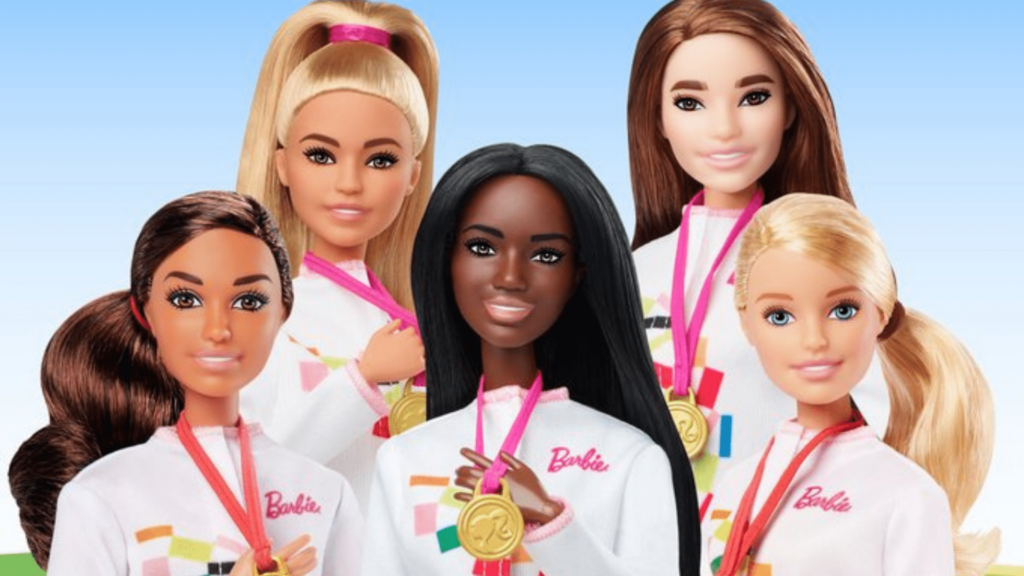Mattel’s most diverse Barbie line yet dropped yesterday, and the world is unimpressed. After one look at the new Barbies, the lack of representation is a giant eyesore on Mattel’s brand and current image. Before the release, Mattel specifically stated they designed these Barbies to represent “inclusivity and innovation”. This is a peculiar statement because the dolls are simply the recreation of white Barbie Dolls with one Black Barbie. The token doll of color, of course, stands at the center as a giant sign of diversity. But these performative steps to say that a brand is inclusive is not the same as doing the work and actually trying to diversify an objectively white standard for Barbie dolls.
If the dolls were not going to be inclusive or representative of all Olympians of color, then Mattel should not have marketed the line as their most diverse collection yet. An even greater feat would be making diverse and inclusive Barbie’s of color — imagine that.

The current line-up of the ‘Tokyo Official” 2020 Olympic Barbies shows three White Barbies, and that is being generous. The remaining two Barbies are Black, or of mixed race representing Mattel’s version of people of color. There is zero Asian representation, no South Asian representation, and a lack of Latin American representation amongst gaps from a variety of regions. Yet, there is room for three white Barbies, which Mattel has already been producing for over 75 years.
Furthermore, the troubling lack of Asian representation in the Tokyo Olympics shows a complete lack of foresight and even common sense.
In this faulty endeavor, Mattel collaborated with the International Olympic Committee (IOC) and Tokyo 2020 organizers. The goal was to showcase each of the five new Olympic sports — softball, sport climbing, karate, surfing, and skateboarding.

One representative came forward stating. “Our intention to represent the Asian community with the Skateboarder doll fell short, and we fully receive and recognize the feedback”.
“Falling short” is an increasingly popular phrase as of late as influencers, companies, and brands fumble when issuing one apology statement after another. In most instances, the answer to not falling short seems crystal clear. An inclusive and diverse line of Olympic Barbies should include Barbies of all colors.
ADVERTISEMENT
Mattel has also created Barbie dolls in tribute to other Asian athletes. They have produced dolls resembling athletes Chloe King, the gold snowboarding medalist in 2018, and the tennis phenomenon Naomi Osaka. This proves they know how to produce Asian Barbie dolls and somehow still “fell short”.
Instantly people took to social media platforms, namely Twitter, to express their discontent.
Twitter user @achoi1973 pointed out that, “to say this was an accident is a joke. I would have more respect if [Mattel] just said we don’t think an Asian Barbie would sell.”
Redish brown eyebrow barbie with corner eye difference is suppose to be Asian. Hahaha. To say this was an accident is a joke. I would have more respect if you just said we didn't think a Asian barbie would sell.
— Alex (@achoi1973) August 10, 2021
Other users poked fun at Mattel for casually “forgetting” that the 2020 Olympics were hosted in Tokyo, Japan.
ADVERTISEMENT
https://twitter.com/xMonteCarlo_/status/1425245791866658818
User Drue Katoka thoroughly points out each disappoint from the Tokyo collection specifically highlighting gold medalist Suni Lee.
Mattel renders #AsianAmericans invisible while
????Touting “most diverse doll line yet”
????highlighting an Asian country
????Featuring #Barbie in Japanese karate uniform
????Branding each doll “Tokyo official”Even as @sunisalee_ an #AAPI, becomes the breakout star of the @Olympics pic.twitter.com/ESW5ykfhXI
— Drue Kataoka (@DrueKataoka) July 31, 2021
As the rebuttal, a spokesperson from Mattel gave a statement ensuring that “moving forward, we will work to find more ways to champion all representation and celebrate the amazing achievements of all Olympic athletes, who are showing us that anything is possible.
Hopefully, when designing their next collection they will look around their showroom for other examples of their previous Barbies of color or look to the world around them to see the true diversity that should be celebrated. “Falling short” can only be said so many times, and for the reason to be a lack of Asian representation for the Olympic Diversity collection in Tokyo, Japan, is just sad.









